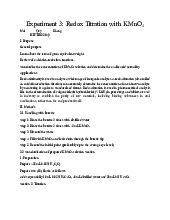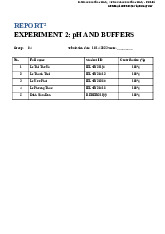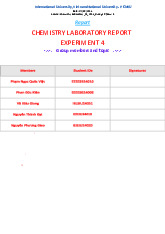





Preview text:
INTERNATIONAL UNIVERSITY HCMC SCHOOL OF BIOTECHNOLOGY ANALYTICAL CHEMISTRY LABORATORY EXPERIMENT 3
PREPARING STANDARD ACID AND BASE GROUP 7
STUDENTS’ NAME: HUYNH THI KHANH LY BTBCIU19009 TRAN NGUYEN HUONG THUY BTBCIU19018 NGO LAN QUYNH BTBCIU19061 NGUYEN TRAN GIA HAN BTBCIU19006 NGUYEN NGOC HUYEN BTBCIU19007 NGUYEN NAM PHUONG BTBCIU19012
INSTRUCTOR: DR. PHAM THI HOA
DATE OF SUBMISSION: DEC 13TH, 2021 SECTION: MONDAY MORNING ABSTRACT
Sodium hydroxide and hydrochloric acid are chemicals extensively utilized in Chemistry. Therefore,
knowing the accuracy concentration of these chemicals is crucial. In this laboratory, potassium hydrogen
phthalate (KHP) was used to determine the exact concentration of sodium hydroxide (NaOH) while the
concentration of hydrochloride acid (HCl) was standardized by using sodium carbonate (Na2CO3).
Through this experiment, all the concentration of NaOH and HCl was calculated, yet only HCl met the criteria. INTRODUCTION
In the laboratory, sodium hydroxide and hydrochloric acid are extensively used reagents. In order to
utilize these reagents accurately, their exact concentrations must be determined. The purpose of this lab
is to be able to determine the exact concentration in molarity (M) through a process called
standardization. Hydrochloric acid (HCl) and sodium hydroxide (NaOH) will be the chemicals that will
be undergoing the standardization. Since NaOH attracts water from the atmosphere and becomes
hydrated, the increasing the error in the mass value of the NaOH recorded. The exact concentration in
molarity will be achieved through an analytical method called titration which will determine the
unknown concentration of the analyte.
Molarity is the most frequent unit of concentration, and it is also the most useful for calculating the
stoichiometry of reactions in solution. The number of moles of solute present in exactly 1 L of solution
is known as the molarity (M). The units of molarity are therefore moles per liter of solution (mol/L),
abbreviated as M. It's also the quantity of millimoles of solute contained in exactly 1 mL of solution:
The process of determining the exact concentration (molarity) of a solution is known as standardization.
Titration is an analytical process that is frequently used in standardization. A titration involves reacting
an exact volume of one substance with a known amount of another substance. In a titration, the endpoint
is the point at which the reaction is completed. To indicate (signal) the endpoint, a chemical substance
termed as an indicator is used. In this experiment, phenolphthalein was utilized as an indicator.
Phenolphthalein, an organic compound, is colorless in acidic solution and pink in basic solution.
Figure 1: Step of titration using Phenolphthalein as indicator
This experiment involves two separate acid-base standardization procedures. The molarity of a sodium
hydroxide solution (NaOH) will be measured in the first standardization by titrating a sample of
potassium acid phthalate (KHP; HKC8H4O4) with the NaOH. In the second step, the molarity of a
hydrochloric solution will be determined using standardized NaOH. In both standardization procedures,
a known volume of the primary standard will be utilized in order to calculate the exact concentration of
NaOH and HCl. Once it is determined that the endpoint has been reached represented by the color
indicators; the data required in order to calculate the exact molarity of the analyte has also been acquired.
A blank titration will also be conducted utilizing NaCl and a subtracted volume of HCl. Without
conducting a standardization procedure, the exact known amounts of molarity cannot be determined. It
is key in maintaining reagents that have exact known amounts of molarity so that experiments may be
conducted with less error and gain consistent product more frequently. MATERIAL AND METHOD 1. Material
In the experiment, the equipment was used included 125 mL beaker, graduated cylinder, 125 mL
volumetric flask, stirring rod, 100 mL beaker, 50 mL burette and 4-digits analytical balance.
The reagents involved in the test were distilled water, NaOH, color indicators include phenolphthalein
and bromocresol, sodium chloride, HCl, the main standards include potassium hydrogen phthalate and sodium carbonate. 2. Procedure • Standardizing NaOH
First, 0.51 grams of Potassium hydrogen phthalate primary standard was dried at 105°C for 1 hour and
stored in a sealed bottle in a desiccator.
Second, 1 L of distilled water was boiled for 5 minutes to remove CO2. Next, a tightly capped
polyethylene bottle was filled with water. The graduated cylinder then transferred 0.48 mL of NaOH to
the water bottle. Biological gloves were used by students in this experiment because NaOH can cause
skin burns. The solution should be mixed well, cooled to room temperature and left overnight.
Third, the 125 mL flask was filled with a solution of 0.51 grams of solid potassium hydrogen phthalate
and approximately 25 mL of distilled water. Each sample must contain enough solids to react with 25
mL of 0.1 M NaOH. Before the titration takes place, the burette was washed with distilled water and
with the titrant before a portion of the NaOH solution was rinsed through the burette to ensure that the
titrant covers the entire surface of the burette. Then, three drops of phenolphthalein were added to each
flask and titration took place in each flask to determine the end point. To prevent the ingress of CO2
from the air, a loosely fitted burette was used in this process.
Fourth, the required volume of NaOH was estimated to be approximately 16 mL for each sample. The
cleaning cycle was repeated several times during the titration by tilting and rotating the flask so that the
liquids from the walls were washed into the general solution. Near the end of the cycle, the amount of
titrant at a time was less than 1 drop. To do so, a droplet from the tip of the burette was carefully
suspended and touched to the inner wall of the flask, after which it was tilted and slowly swirled to wash
into the general solution. The titration was terminated when a faint pink color appeared and persisted
for 15s. As CO2 from the air dissolves in solution, the color slowly fades. The whole process was
repeated three times for the most accurate results. • Standardizing HCl
First, the table on the front of the textbook was used to calculate the volume of approximately 37% by
mass of HCl that needs to be added to 1 L of distilled water to make 2.28 mL of 0.1 M HCl and prepare the solution.
In the second step, 0.1325 grams of primary standard sodium carbonate was dried for 1 h at 105 °C and cooled in a desiccator.
As a third step, four samples consisting of 0.1325 grams of Na2CO3 and 25 mL of 0.1 M HCl were
carefully weighed and placed in a 125 mL flask before the solution was dissolved in 25 mL of distilled
water. Then, three drops of bromocresol blue indicator were added to the flask and the titration was
carried out rapidly until green color appeared and the endpoint was determined.
In the fourth step, each sample was carefully titrated until the blue color fades away and turns to green.
Besides, to remove CO2, the solution needed to be boiled and the blue color will return. Then, the burette
was used to transfer HCl into the solution until a green color appeared. The volume of acid at this time was recorded.
In the fifth step, a blank was titrated with 50 mL of 0.05 M NaCl and 3 drops of indicator. The required
volume of HCl was added to the blank for the Na2CO3 titration.
Finally, quantities such as mean HCl molarity, standard deviation and relative standard percent deviation
were calculated according to the formula
RESULTS & DISCUSSION Calculation: • Standardizing NaOH 50 wt% NaOH:
In order to make 150 mL (= 0.015 L) of 0.1M NaOH, we first calculate the moles of NaOH that we need:
. Then, the mass of solid was calculated: m = n x M = 0.015 x 39.91 =
0.6 g. After that, the volume of the NaOH solution was based on the density:
. Therefore, the mass and volume of NaOH which were taken from the stock were 0.6g and 0.48mL respectively
Table 1: The standardizing of NaOH 1 2 3 4
Mass of Potassium hydrogen phthalate (g) 0.5107 0.5119 0.5143 0.5186 Moles of NaOH (mol) 0.002501 0.002507 0.002518 0.002539 Volume delivered (L) 0.0472 0.0477 Molarity NaOH (M) 0.05298 0.05255 Average molarity (M) 0.05277 Standard deviation (M) 0.0003536
Relative standard deviation (%) 0.670045557
According to the table 1, the results were determined by some equations:
Moles of NaOH = Moles of Potassium hydrogen phthalate = = = 0.002501 mol Molarity of NaOH = = = 0.052982 M Average molarity: = = = 0.05277 M Standard deviation: s = = = 0.0003536 M
Relative standard deviation = 100 x = 100 x = 0.67% • Standardizing HCl Molarity of HCl: M= = 11.97M V1C1 = V2C2 V1 = = 2.08ml
So, 2.08ml solution needed to make 250ml 0.1M HCl solution.
Following the data, the mass of Na2CO3 and NaCl were mNa2CO3 = 0.1325g and mNaCl = 0.585
Table 2: Standardizing of HCl 1 2
Volume delivered before boiled (L) 0.0239 0.0233
Volume delivered after boiled (L) 0.0240 0.0234 Moles of HCl (mol) 0.0025 Molarity HCl (M) 0.1061 0.1089 Average molarity (M) 0.1075 Standard deviation (M) 0.0019
Relative standard deviation (%) 1.79
According to the table 2, the results were determined by some equations:
Moles of HCl = 2 x Moles of Na2CO3 = = Molarity of HCl = = = 01061 M Average molarity: = = = 0.1075 M Standard deviation: s = = = 0.0019 M
Relative standard deviation = 100 x = 100 x = 1.79% Discussion:
In this experiment, preparing a standard acid or base was achieved by determining the exact values of
mass and volume. Sodium hydroxide (NaOH), a strong base, and hydrochloric acid (HCl), a strong acid
would be the two chemicals used to standardize during this laboratory.
For highly accurate and precise standardization processes, this experiment would utilize primary
standard reagents, which had high purities, high molecular weights, and were stable; therefore,
potassium hydrogen phthalate (KHP) and sodium carbonate (Na2CO3) were used. In addition,
standardizing NaOH utilized phenolphthalein indicator while standardizing HCl utilized bromocresol
green indicator. A blank titration was carried out to determine the errors in future titrations using the same solvent.
Based on the results for standardization of NaOH, the average molarity of NaOH was 0.5277*10-1 M
with the standard deviation of the molarity of 0.3536*10-3 M, and the percent relative standard deviation
was 0.67004%. According to the theoretical section, there were four trials in total; however, it was
impossible to make calculations for trial 3 and trial 4 since the data were not collected sufficiently.
Therefore, only the results taken from the first two trials were calculated. In lab manual, it noted that the
percent relative standard deviation should be less than 0.2% if the titration was done carefully. However,
in this report, the value was greater than 0.2%, so it could not satisfy the criteria.
Based on the above results for standardization of HCl, the average molarity of HCl was 0.1075 M with
the standard deviation of the molarity of 0.19*10-2 M, and the percent relative standard deviation was
1.79%. The volume of HCl titrant used for blank titration was 0.1mL.
After analyzing the results, it could be seen that in both standardizations, the standard deviations were
small, which indicated a high precision among the values. Also, the percent relative standard deviations
were small as well, showing that the data was clustered tightly around the mean value.
When conducting an experiment, errors were likely to exist, and this laboratory was not an exception.
Sources of errors might come from old equipment and improper burette technique during the
performance. Old equipment consisted of old burettes, cracked graduated cylinders, rusted analytical
balances, etc. Besides, some other problems in performing the burette technique including the solutions
inside the flasks were not equally and frequently swirled, errors in reading the burettes called parallax,
the presence of air bubbles inside the burette and on its tip, or the likelihood that the volume recorded
at the endpoint after each titration trial might be greater than the actual volume needed to reach the
endpoint, which meant overshooting the endpoint, if performers did not titrate carefully. Last but not
least, this experiment was also performed by the teaching assistant; thus, techniques and recorded results
would be significantly affected. CONCLUSION
In this experiment, the concentration of hydrochloric acid was successfully determined by using sodium
carbonate (Na2CO3) with the percent relative standard deviation 1.79%, while the standardizing of
sodium hydroxide by potassium hydrogen phthalate (KHP) was exceeded the critical value of 0.2%.
This laboratory was an opportunity for students to improve the hands-on technique in titration. Things
that needed to be noticed in this laboratory were reading the burette carefully and removing the air
bubbles when conducting the experiment. REFERENCES
Harris, D. C. (2015). Quantitative Chemical Analysis (9th ed.). W. H. Freeman.




